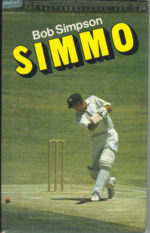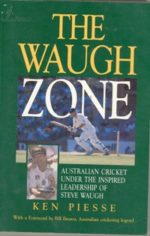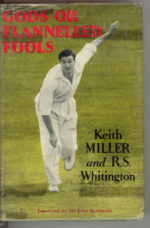Description
Softback, limited to 200 copies
Signed by the author Mike Sexton
Additional information
| Type / Condition | |
|---|---|
| Year Of Publication |
1 review for Sexton, Michael – Three Summers of Sobers (signed), last copies
Add a review Cancel reply
You must be logged in to post a review.
Related products
-
Sale!

Piesse, Ken – Cricket’s Greatest Scandals
Rated 0 out of 5$22.00$13.75 Add to cart -

Simpson, Bob – Simmo (1979 autobiography)
Rated 0 out of 5$11.00 Add to cart -
Sale!

Piesse, Ken – The Waugh Zone, signed
Rated 0 out of 5$22.00$11.00 Add to cart -

Miller, Keith – Gods or Flannelled Fools (1953 Ashes tour)
Rated 0 out of 5$22.00 Add to cart



Ken –
Exactly 60 summers ago, Garfield Sobers arrived in Adelaide to play district cricket with Prospect and Sheffield Shield for South Australia and in doing so lit a fuse of excitement that re-invigorated the game and is still spoken about with reverence and awe.
‘Sobey – where do you start?’ says Ken ‘KG’ Cunningham who played alongside the champion West Indian. ‘He could have been picked just for his fielding he was that good. He could bat anywhere in the order and make runs with shots you have never seen before and he was three different bowlers – pace, orthodox and leggies. To call him awesome is an understatement.’
The deal to bring Sobers to South Australia was orchestrated by Sir Donald Bradman who had been transfixed by the West Indies tour of 1960-61. The series is widely regarded as one of the greatest Test tours ever staged. The captains Richie Benaud and Frank Worrell led with great spirit, allowing thrilling cricket that resulted in a 2-1 win to Australia, a nail-biting draw at Adelaide and the first ever tied Test match in Brisbane.
Bradman saw that the series had put some wind in the sails of a game that had been caught in the doldrums during the late 1950s. The following summer was domestic only with no international team scheduled and so an opportunity arose to invite some of the West Indians to return. Wes Hall played in Queensland and led Shield wicket takers with 43 scalps while Rohan Kanhai scored 490 runs for Western Australia including a superb 135 against South Australia. But neither generated the kind of excitement that buzzed around Garry Sobers.
Keith Miller called Bradman the greatest batsman of all time but regarded Sobers as the greatest cricketer who ever played. His assessment was based on his ability to bat in the top order and either open the bowling with the new ball or use the old ball for spin.
‘He was three players in one,’ is how Ian McLachlan summed him up.
Sixty years on, McLachlan can still recall one shot Sobers played in an innings of 251 against New South Wales at the Adelaide Oval in February 1962.
‘Alan Davidson came on with the third new ball, so we were going well and he [Sobers] was 200 and something. The first ball went past square leg along the ground for four and the next ball went back past Davidson for four and so Alan tried to bowl him a bouncer which got up to about chest height. He leant back with a perfectly straight bat and with all that amazing flexibility that you used to see with Tiger Woods on the golf course, he hit a six which landed just five yards short of the right-hand part of the bar. I measured it one day and it was about 135 yards off the back foot with those light bats. Bradman said it was the best shot he ever saw although he wasn’t mad keen on people hitting sixes.’
After his first season, Sobers agreed to return and for the next two years set a record by scoring more than 1000 runs and taking 50 wickets. His play brought a promising team to the boil and South Australia won the Shield after a 10-year drought. Sobers thrived under the aggressive captaincy of Les Favell and influenced a teenage Ian Chappell. He also invigorated the game at its grass roots by holding dozens of clinics at schools across the vast state.
For all he gave cricket in South Australia what did South Australia give Garry Sobers? Geoff Boycott is of the opinion Sobers was a better player after his three seasons because he developed his quick bowling, which he compares in speed and swing to Jimmy Anderson. On a more practical level South Australians arranged and paid for him to see a Harley Street specialist in 1962 to have a troublesome knee operated on, something Sobers said saved his cricket career.
‘I got to know Australia and grew to love it – especially Adelaide,’ said Sobers.
The feeling was mutual. – MS